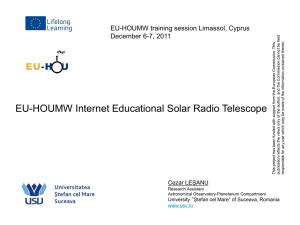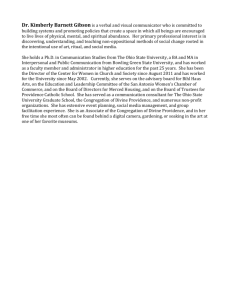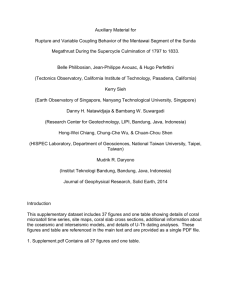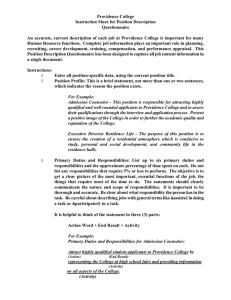stevenson - ladd observatory
advertisement
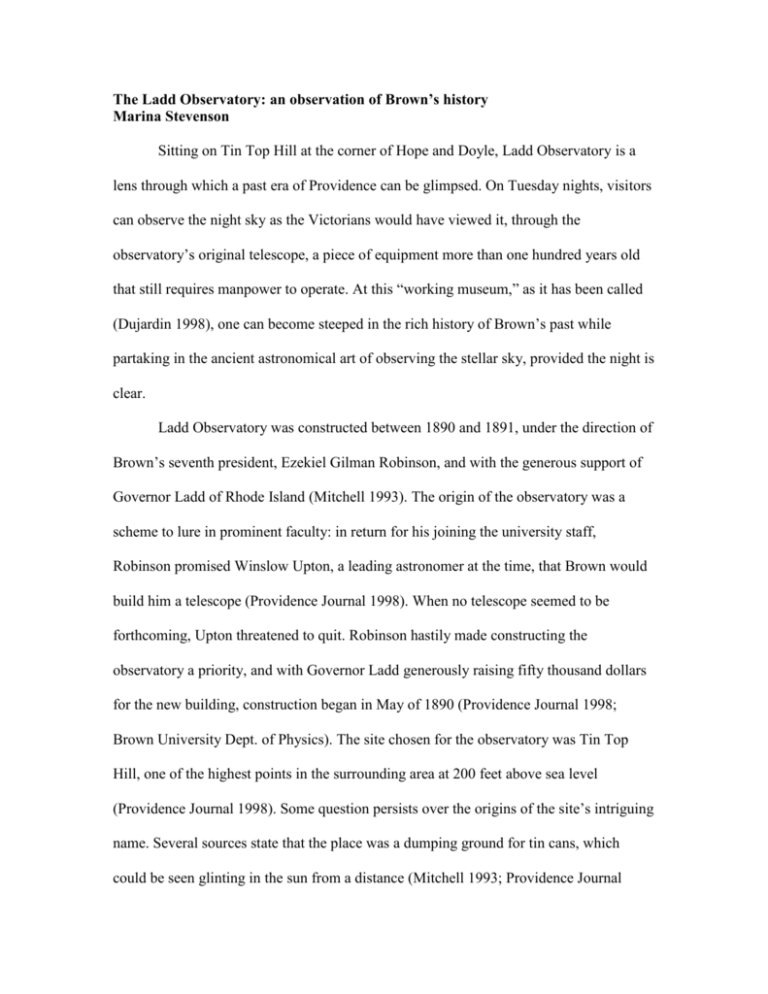
The Ladd Observatory: an observation of Brown’s history Marina Stevenson Sitting on Tin Top Hill at the corner of Hope and Doyle, Ladd Observatory is a lens through which a past era of Providence can be glimpsed. On Tuesday nights, visitors can observe the night sky as the Victorians would have viewed it, through the observatory’s original telescope, a piece of equipment more than one hundred years old that still requires manpower to operate. At this “working museum,” as it has been called (Dujardin 1998), one can become steeped in the rich history of Brown’s past while partaking in the ancient astronomical art of observing the stellar sky, provided the night is clear. Ladd Observatory was constructed between 1890 and 1891, under the direction of Brown’s seventh president, Ezekiel Gilman Robinson, and with the generous support of Governor Ladd of Rhode Island (Mitchell 1993). The origin of the observatory was a scheme to lure in prominent faculty: in return for his joining the university staff, Robinson promised Winslow Upton, a leading astronomer at the time, that Brown would build him a telescope (Providence Journal 1998). When no telescope seemed to be forthcoming, Upton threatened to quit. Robinson hastily made constructing the observatory a priority, and with Governor Ladd generously raising fifty thousand dollars for the new building, construction began in May of 1890 (Providence Journal 1998; Brown University Dept. of Physics). The site chosen for the observatory was Tin Top Hill, one of the highest points in the surrounding area at 200 feet above sea level (Providence Journal 1998). Some question persists over the origins of the site’s intriguing name. Several sources state that the place was a dumping ground for tin cans, which could be seen glinting in the sun from a distance (Mitchell 1993; Providence Journal 1998). The Rhode Island Geodetic Society, however, states that the summit’s name “came from a bright piece of tin, conical in shape, hung in a very high oak tree and used as a sight by navigators and surveyors” (Rhode Island Geodetic Society 1935). The tree was cut down in 1907, however, to make room for a house at 207 Doyle, and the fate of the tin cone remains unknown (Rhode Island Geodetic Society 1935). By the time the new observatory opened to the public on October 21, 1891, an impressive new facility had been erected. The observatory measured 43 x 27 feet, with a 21-foot diameter dome made of copper sheets on a steel framework (Mitchell 1993). It had a flat roof that astronomy classes could use for observation, and a 15 x 25 foot ell at the rear containing two transit instruments and shutters on the roof for their use (Mitchell 1993). The building had a masonry pier independent of the rest of the structure to support the weight of the telescope, a device with 15 feet of focal length and a 12-inch aperture (Brown University Dept. of Physics; Mitchell 1993). The masonry pier also contained two clock vaults, “to provide a vibration-free and temperature-stable environment for precision timekeeping” (Brown University Dept. of Physics). One of the clock vaults— the other is now unused—currently houses “three precision time-keeping instruments, each more than 100 years old. They include a master clock made by Sigmund Riefler, a German engineer whose timepieces were standard features in most of the world's observatories” (Dujardin 1998). For many years, in fact, Ladd Observatory provided the official time in Rhode Island, sending electric signals to several points in the area every day at noon so that clocks could be set to the correct time. This practice was finally ended in 1973 when it was discovered that no one was actually receiving them any longer (Mitchell 1993). The Observatory, however, proved to be an important feature of Providence for more than just chronological reasons. It was also a keeper of weather records, beginning in 1893; a site for testing civil air raid sirens during World War II; and, most importantly, a place of education for the students of Brown University and the people of Providence (Mitchell 1993). From its inception, the observatory’s three goals were to furnish timekeeping for the city of Providence; to be of service in astronomical research; and to provide instruction in astronomy to students at Brown (Mitchell 1993). Traditionally, it has also provided education to the general public through its open observation hours on Tuesday evenings. Since the observatory’s construction, Providence and the Ladd have both seen many changes. The surrounding area of Tin Top Hill, which used to be accessed by a “rough country road,” now has Hope Street and many more houses than it did when the observatory was built (Rhode Island Geodetic Society 1935). The observatory’s management has passed through many hands, from individual professors to the management of the Brown physics department, and a renovation that ended in 1998 has seen some new additions tacked on to the building: a second exit to bring it up to fire safety code, an elevator for increased accessibility, and an adjacent park with elegant arches and benches where formerly there were a house and a dirt lot (Providence Journal 1998; Dujardin 1998). The heart of Ladd Observatory, however, remains unchanged. The building itself—with its wheel-and-cog telescope than still requires cranking by hand to rotate, its original astronomical instruments (each more than a hundred years old), and its feel of a “working museum”—offers a glimpse of what astronomy was like more than a century ago. ‘“There are some observatories that are older,” [Dean] Targan acknowledged [at the observatory’s re-opening in 1998]. “But all those that are open to the public have been upgraded so that you don't get the same sense that you do here of what it was like, and still is like, to simply walk off the street and look at the night sky”’ (Dujardin 1998). References: “About the Observatory.” Brown University Department of Physics webpage. “Ladd Observatory Observed.” Providence Journal. 25 July 1998: A-10. Mitchell, Martha. “Ladd Observatory.” Encyclopedia Brunoniana. Providence, RI: Brown University Library, 1993. “Seeing Stars: The Ladd Observatory reopens with major improvements, inside and out, but except for cleaning of the handcrafted lens, the brass telescope retains its original Victorian form.” Richard C. Dujardin. Providence Journal. 13 October 1998: C-01. “Station Description: Described by Rhode Island Geodetic Society 1935.” 1935 Surveying Report, Rhode Island Geodetic Society. Accessible at ngs.noaa.gov. All images (see below) are from the Brown University Department of Physics website. Views of Ladd Observatory Ladd Observatory, which opened in 1891. Tin Top Hill, one of the highest points in Providence, and the renovated observatory. The observatory under construction in 1890. The masonry pier that supports the telescope is visible in the center. The telescope at Ladd Observatory. Powered by a wheel-and-cog mechanism, it is still rotated by hand.


